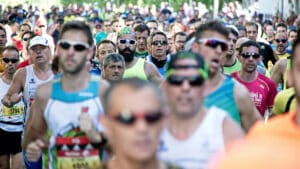A few years ago, I received a phone call from Adrian Chiles, the television and radio presenter, who was running a marathon – I understand from google he ran three marathons in his running career.
He asked about doing, what he called, lots of jogging – i.e., running lots of miles much slower than his target marathon time.
I think I miss-understood where he was coming from. He questioned me lots on why so much slow running. I tried to explain how building an aerobic base was key to building an efficient engine.
I didn’t have time to think, questions were being fired at me quickly during the phone interview.
What I neglected to say is that it shouldn’t all be that slow and a lot of it should be at the faster end of aerobic capacity. I did mention, I recall, that running some faster intervals anaerobically will balance out the fact that a lot of training is aerobic.
How Training Theories Evolve
During my formative years as a young athlete, the perceived wisdom was to use interval training as a way of introducing speed into training. Down at my first running club in Folkestone, under the club coach, we ran three times a week in the summer doing interval running on a grass track (I was 14).
However, at the same time I was becoming more broadly interested in the sport as there were some colourful characters.
I read that someone called Dave Bedford had won the South of England Senior Cross Country Champs over 9 miles, when he was still a junior. Not satisfied with that he then immediately went from the finish to join the start line of the South of England Junior race, and promptly won that over 6 miles.
In a magazine type book on Dave Bedford’s running life, in the late 1960’s/early 1970’s, it mentioned that he had experimented with running up to 200miles a week. Dave was a World Cross Country Champs winner and also set a world record over 10,000m on the track of 27.30.
He looked a bit of a hippy, with his long hair, Zapata style moustache, long red socks and black adidas spikes. I was hooked.
British Milers Club
In 1971 I made the Kent team for the English Schools Track & Field Championships. They were to be held on an all-weather track surface at Crystal Palace, the first time I had experienced that, and in front of an attendance of about 17,000 in the stadium – a far cry from the Kent Champs 1,500m, held on a grass track at a Ramsgate school, that got me into the team.
I ran a pb of 4min7.7sec for 7th place in the Intermediate boys 1,500m final. This proved good enough to get me qualification to join the British Milers Club, a prestigious club set up to improve the standard of British middle distance running by the charismatic coach, Frank Horwill.
I asked Horwill for some sessions for me to do to improve. He sent me a copy of a training plan for a senior runner, Jim Douglas, who had a 3.55 mile best. The take-out sessions recommended were: 1hr of fartlek running and 30 x 200m with a 100m jog recovery (not on the same day!). I was only 15 at the time….but I did it.
Meantime, two local Folkestone runners, Len Slater and Dave Rumsey, where getting into the Kent senior cross-country team, and they were running 10-mile road runs in the North Downs around Folkestone, so I started to join them.
The longer run bug caught hold, and I joined a sponsored walk in Elham Valley, between Folkestone and Canterbury. Good runners from the Canterbury based running club, Invicta, also used the organisation of the walk to do their Sunday long run. So, I ended up, as a teenager, tagging on to some county level senior runners, doing a 20-mile run. I later found out that they were annoyed that they couldn’t drop the young upstart – although I’m sure, they were pleased some years later, that I joined Invicta!
So, I started to think about long runs. My first attempt to do one as a training run could only be described as ‘blood and gore’. I blasted the cliff top slopes between Folkestone and Dover, this before a long climb back towards Folkestone along the Alkham Valley.
It ended in me having to stop after about 16 miles, completely blown up, with Dave Rumsey running on to get a car to pick me up, while I sat in a bus shelter in Hawkinge!
What did I learn, simple, if you go too fast you will run out of energy. Also, that chunks of toast & jam, and endless mugs of tea, are the best way to recover from the drama of a bad long run experience!
Educating Myself with Lydiard
Despite the mess of my first long run, I began to realise that there was something in doing the long run. I won the English Schools 5,000m senior title and ran a 30 min 10,000m on the track, as a teenager.
I also did a 1-hour track race, in fact three of them in my career. The second one was as a teenager on a camping trip to the Isle of White. I stumbled on the Ryde Harriers club championship weekend and asked if I could do the hour race. I don’t remember the distance covered in the hour – I won the race and did, I think, something around 12 miles.
I then went back the next day and won the 400m in 51 seconds.
After this holiday, I was heading to Sussex to do a Physical Education degree.
I had also qualified as an athletics coach at this time, while still at school, with a British Amateur Athletics Board Club Coach award (as the governing body was then called) and was coaching a group of Folkestone runners.
In advance of the coaching award and going to college, I tried to read up on athletics and came across the coaching books by Arthur Lydiard from New Zealand, who coached several Olympic Champions from the 1960’s, including Peter Snell, who ran 1.44.3 for the 800m WR at the time, off a combination of high mileage balanced with specific event speed work.
I also read about Percy Cerutty from Australia, coach to Herb Elliot, who took Olympic 1,500m gold as well as the 1,500m WR. Cerutty seemed to be a little eccentric, had his athletes run in natural surroundings and found ways to impart mental toughness. One story I came across is that he had Elliott run a long way out to an area of Sand dunes, then do a hard session up and down them. When the session was over, and Elliott exhausted, he said, that’s good, now run back.
Guess what – when I got to college in Sussex, I found some sand dunes along the coast at Climping, near Littlehampton, I’d run several miles to get to them along the beach from Bognor Regis, where I was living as a student, do the session on the dunes, then run back!
Two Big Influences
When I settled into college life and found the library, I found the most important part about it. Not the books, but the head librarian was a 2.17 marathon runner called Rab Heron. We started to do 20 miles in the South Downs regularly, and also some 8-to-10-mile midweek runs.
We also both joined Brighton & Hove Athletic Club. Here we found a middle distance group that included Steve Ovett, who was Montreal bond to run in the Olympic 800m, where he made the final as a teenager.
In Brighton, the leader of the group was Matt Paterson. A tough trainer, who had us doing winter session of 5 sets (5 x 300m) 100 jog recoveries. These were done between 42 and 45 seconds, so not slow. He also ran 100-mile weeks in winter over the Downs at Brighton, with Ovett.
A Training Style Emerged
I made slow progress at college, not for want of trying, I was certainly training hard enough, but a student lifestyle did seem to get in the way.
It was a few years later, when I had found a teaching job in Broadstairs and moved to Kent to live, that a way of training emerged.
I joined Invicta, who’s seniors I’d frustrated on that 20-mile run several years earlier. My school friend from Folkestone days, Len Slater, had also moved to Canterbury and was training for the marathon. A few others from the club had started to think about the marathon distance, and a club trip to Paris for the Essonne Marathon got organised for April 1969. I had no marathon plans, but ran 51 minutes for a 10 mile race in March, so decided I would tag along.
Barry Watson, who had run the Montreal Olympic Marathon for GB, was there, and club teammate, Martin Knapp, who I often finished close to in races. So, I decided to track them in the race for as long as I could. In the end I ended up 11th with 2.21.30; Knapp in 10th, and Watson in 9th, both just up the road, I could see them finish. Len Slater dropped out.
To say the result was a surprise is an understatement. I started to look at why I had found I had such good endurance for the marathon, when I had actually been training for 5,000m and 10,000m.
I looked back at Lydiard’s book, and his theories of aerobic capacity building through long runs. Considered the three years of doing 20’s with Rab Heron, and the three years of doing big interval track sessions with Ovett at Brighton. A system, I could say was mine, was there.
So, I came up with my own training theories based on experiences with other training partners, chats with coaches, such as Cliff Temple and Bruce Tulloh, and trial-and-error on the best total weekly mileage for me.
The system became:
- Lots of long slow to steady runs on trails with Invicta in the Winter.
- Build to 120 miles a week.
- Switch to progressively faster long runs from about 20 weeks before the target marathon.
- Work on long track sessions, mostly at 5km pace, such as 20 x 400m/100m float recovery, 400m laps in 67’s.
- Plenty of cross country, road and relay races to act as what we would now call threshold or tempo runs.
- Hills for several weeks 16 weeks out.
- Fast track workouts from 4 weeks out – 8 x 400m/200 jog, 58 sec laps.
My main recommendations are aligned, I think with the principles of aerobic base building, used by Lydiard. This, had resonance, particularly in the period in the early 1970’s, when Lydiard went to to Finland, via the USA, and succeeding in moving the Finish athletes from a diet of interval training, to a diet of long runs, that produced Lasse Viren, 4 times Olympic gold medallist. A film of Virens training at that time really impressed me.
PS. Recent reports of a Norwegian system that is currently producing the likes of Jacob Ingebrigtsen, is of running 110 miles/week, mostly aerobic running (my guess is about 90% of training is aerobic), and two days a week consisting of long reps at threshold pace in the morning, followed in the afternoon by an interval session, at just over the anaerobic threshold. This seems to me a more scientific variation of an old theme, with lactate levels carefully controlled on the two anaerobic days to avoid training too hard.


















